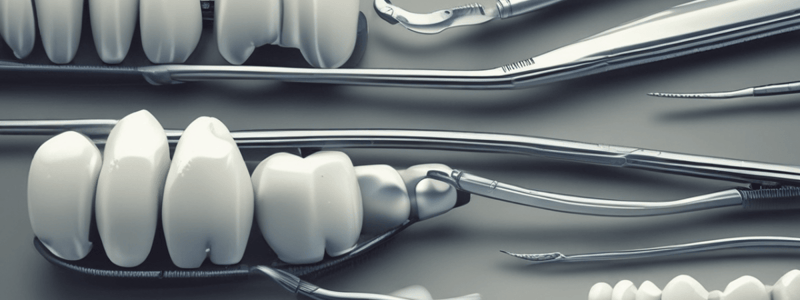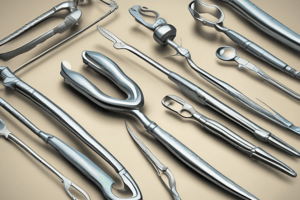Podcast
Questions and Answers
What is the primary consequence of using a dull hand cutting instrument during an operative procedure?
What is the primary consequence of using a dull hand cutting instrument during an operative procedure?
- Loss of control and increased pain (correct)
- Reduced time for the procedure
- Enhanced precision in tooth preparation
- Improved control over the instrument
What is the purpose of using a stationary sharpening stone, such as an Arkansas stone?
What is the purpose of using a stationary sharpening stone, such as an Arkansas stone?
- To reduce the quality of tooth preparation
- To sharpen the instrument's cutting edge (correct)
- To move the instrument at high speed
- To sharpen the instrument quickly
Which grasp is used for lingual and labial surfaces of upper anterior teeth?
Which grasp is used for lingual and labial surfaces of upper anterior teeth?
- Inverted pen grasp
- Modified pen grasp (correct)
- Modified palm and thumb
- Palm and thumb
What is the importance of rest and guard in grasping hand cutting instruments?
What is the importance of rest and guard in grasping hand cutting instruments?
What is the advantage of using a mechanical sharpener?
What is the advantage of using a mechanical sharpener?
What is the primary consequence of prolonged time for an operative procedure?
What is the primary consequence of prolonged time for an operative procedure?
How many grasps are used with hand cutting instruments?
How many grasps are used with hand cutting instruments?
What is the function of the thumb in the inverted pen grasp?
What is the function of the thumb in the inverted pen grasp?
What is the primary purpose of sharpening hand cutting instruments?
What is the primary purpose of sharpening hand cutting instruments?
What is the primary function of an ordinary hatchet in tooth preparation?
What is the primary function of an ordinary hatchet in tooth preparation?
What is the characteristic of the primary cutting edge of a hoe excavator?
What is the characteristic of the primary cutting edge of a hoe excavator?
What is the specific use of an angle former in dentin preparation?
What is the specific use of an angle former in dentin preparation?
What is the specific use of a spoon excavator?
What is the specific use of a spoon excavator?
What is the characteristic of the cutting edge of an ordinary hatchet?
What is the characteristic of the cutting edge of an ordinary hatchet?
In which type of preparations is a hoe excavator commonly used?
In which type of preparations is a hoe excavator commonly used?
What is the function of an angle former in enamel margins?
What is the function of an angle former in enamel margins?
What is the characteristic of an angle former?
What is the characteristic of an angle former?
What is the availability of angle formers?
What is the availability of angle formers?
What is the purpose of a GMT instrument?
What is the purpose of a GMT instrument?
What is the characteristic of a chisel with a distal bevel?
What is the characteristic of a chisel with a distal bevel?
What is unique about the GMT instrument's cutting edge?
What is unique about the GMT instrument's cutting edge?
What is the purpose of an enamel hatchet?
What is the purpose of an enamel hatchet?
What is the characteristic of a chisel with a mesial bevel?
What is the characteristic of a chisel with a mesial bevel?
What is the characteristic of a GMT instrument?
What is the characteristic of a GMT instrument?
What is the purpose of a chisel in direct gold restorations?
What is the purpose of a chisel in direct gold restorations?
What is the characteristic of the blade of an enamel hatchet?
What is the characteristic of the blade of an enamel hatchet?
What is the purpose of a GMT instrument in preparing proximo-occlusal preparations?
What is the purpose of a GMT instrument in preparing proximo-occlusal preparations?
What is the primary function of a negative rake angle in bur design?
What is the primary function of a negative rake angle in bur design?
What is the maximum displacement from the central axis allowed for bur eccentricity?
What is the maximum displacement from the central axis allowed for bur eccentricity?
What is the purpose of crosscuts on fissure burs?
What is the purpose of crosscuts on fissure burs?
What is the main disadvantage of carbide burs?
What is the main disadvantage of carbide burs?
What is the purpose of bur locking or shank design?
What is the purpose of bur locking or shank design?
What is the main disadvantage of steel burs?
What is the main disadvantage of steel burs?
What is the relationship between rake angle and cutting edge?
What is the relationship between rake angle and cutting edge?
What is the effect of eccentricity or run-out on cutting efficiency?
What is the effect of eccentricity or run-out on cutting efficiency?
What is the purpose of measuring concentricity in bur design?
What is the purpose of measuring concentricity in bur design?
What is the difference between cutting effectiveness and cutting efficiency?
What is the difference between cutting effectiveness and cutting efficiency?
What is the primary advantage of using high speed hand pieces in operative dentistry?
What is the primary advantage of using high speed hand pieces in operative dentistry?
What is the primary function of the blades in a dental cutting tool?
What is the primary function of the blades in a dental cutting tool?
What is the characteristic of diamond points that makes them more effective for extra-coronal tooth preparations?
What is the characteristic of diamond points that makes them more effective for extra-coronal tooth preparations?
What is the primary benefit of using carbide burs in operative dentistry?
What is the primary benefit of using carbide burs in operative dentistry?
What is the primary consideration when selecting a material for a dental cutting tool?
What is the primary consideration when selecting a material for a dental cutting tool?
What is the purpose of the shank design in a dental cutting tool?
What is the purpose of the shank design in a dental cutting tool?
What is the primary effect of eccentricity in a dental cutting tool?
What is the primary effect of eccentricity in a dental cutting tool?
What is the primary function of the rake angle in a dental cutting tool?
What is the primary function of the rake angle in a dental cutting tool?
What is the primary advantage of using abrasive stones in operative dentistry?
What is the primary advantage of using abrasive stones in operative dentistry?
What is the primary characteristic of the cutting edge of a carbide bur?
What is the primary characteristic of the cutting edge of a carbide bur?
Flashcards are hidden until you start studying
Study Notes
Importance of Sharpening Hand Cutting Instruments
- Dull instruments cause loss of control, more pain, prolonged operative procedure, and reduced quality and precision of tooth preparation.
- Sharpening keeps the cutting edge sharp, ensuring efficiency and effectiveness in tooth preparation.
Methods of Sharpening Hand Cutting Instruments
- Stationary sharpening stone (e.g., Arkansas stone, silicon carbide)
- Mechanical sharpener (easier and less time-consuming)
Importance of Rest and Guard
- Rest: the adjacent teeth act as a rest, providing support and stability during the procedure.
- Guard: the thumb, index, and middle fingers contact the instrument, while the ring and little fingers rest on the adjacent teeth, ensuring proper control and precision.
Hand Instrument Grasps
- Modified pen grasp: similar to holding a pen, with the thumb, index, and middle fingers contacting the instrument.
- Inverted pen grasp: the handle is placed in the palm, and the thumb rests on the nearby tooth, used for lingual and labial surfaces of upper anterior teeth.
- Modified palm and thumb grasp
- Palm and thumb grasp
Types of Hand Cutting Instruments
- Excavators:
- Ordinary hatchets (bibeveled, for preparing retentive areas and sharpening internal line angles)
- Hoes (primary cutting edge perpendicular to the axis of the handle, for planning tooth preparation walls and forming line angles)
- Angle formers (mon-angled, for sharpening line angles and creating retentive features in dentin)
- Spoon excavators (discoid or cleoid, for removing caries and carving amalgam or direct wax patterns)
- Chisels:
- Straight, curved, and bin-angle chisels (for cutting enamel)
- Enamel hatchets (beveled on one side, for cutting and planning enamel)
- Gingival margin trimmers (for rounding or beveling gingival enamel margins)
Rotary Instruments
- Components of rotary system:
- Source of power (electric driven or air driven)
- Hand piece (low speed or high speed)
- Cutting tool (dental bur or abrasive stone)
- Advantages of high-speed hand pieces:
- Faster removal of tooth structure with less pressure and vibration
- Reduced operating time
- Operator has better control and greater ease of operation
- Instruments last longer
- Patients are generally less apprehensive
- Dental burs:
- Carbide burs (better for end cutting, produce lower heat generation)
- Diamond points (produce more friction, high heat generation, effective for extra-coronal tooth preparations and beveling enamel margins)
- Abrasive tools (stones):
- Metal blank + binder + abrasive particles
- Cuts by abrasion
Studying That Suits You
Use AI to generate personalized quizzes and flashcards to suit your learning preferences.




